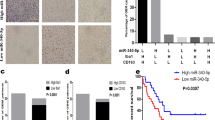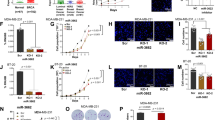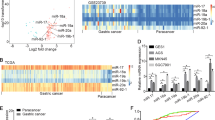Abstract
One of the hallmarks of malignancy is the polarization of tumor-associated macrophages (TAMs) from a pro-immune (M1-like) phenotype to an immune-suppressive (M2-like) phenotype. However, the molecular basis of the process is still unclear. MicroRNA (miRNA) comprises a group of small, non-coding RNAs that are broadly expressed by a variety of organisms and are involved in cell behaviors such as suppression or promotion of tumorigenesis. Here, we demonstrate that miR-19a-3p, broadly conserved among vertebrates, was downregulated in RAW264.7 macrophage cells of the M2 phenotype in conditoned medium of 4T1 mouse breast tumor cells. This downregulation correlated with an increased expression of the Fra-1 gene, which was reported to act as a pro-oncogene by supporting the invasion and progression of breast tumors. We found significant upregulation of miR-19a-3p in RAW264.7 macrophages after transfection with a miR-19a-3p mimic that resulted in a significant suppression of the expression of this gene. In addition, we could measure the activity of binding between miR-19a-3p and Fra-1 with a psiCHECK luciferase reporter system. Further, transfection of RAW264.7 macrophage cells with the miR-19a-3p mimic decreased the expression of the Fra-1 downstream genes VEGF, STAT3 and pSTAT3. Most importantly, the capacity of 4T1 breast tumor cells to migrate and invade was impaired in vivo by the intratumoral injection of miR-19a-3p. Taken together, these findings indicate that miR-19a-3p is capable of downregulating the M2 phenotype in M2 macrophages and that the low expression of this miRNA has an important role in the upregulation of Fra-1 expression and induction of M2 macrophage polarization.
This is a preview of subscription content, access via your institution
Access options
Subscribe to this journal
Receive 50 print issues and online access
$259.00 per year
only $5.18 per issue
Buy this article
- Purchase on Springer Link
- Instant access to full article PDF
Prices may be subject to local taxes which are calculated during checkout






Similar content being viewed by others
References
Eulalio A, Schulte L, Vogel J . The mammalian microRNA response to bacterial infections. RNA Biol 2012; 9: 742–750.
Kincaid RP, Burke JM, Sullivan CS . RNA virus microRNA that mimics a B-cell oncomiR. Proc Natl Acad Sci USA 2012; 109: 3077–3082.
Thomas RM, Fleming JB . MicroRNA dissects out dangerous pancreatic cysts from all the rest. Clin Cancer Res 2012; 18: 4482–4484.
De Vito C, Riggi N, Cornaz S, Suva ML, Baumer K, Provero P et al. A TARBP2-dependent miRNA expression profile underlies cancer stem cell properties and provides candidate therapeutic reagents in Ewing sarcoma. Cancer Cell 2012; 21: 807–821.
Garzon R, Marcucci G . Potential of microRNAs for cancer diagnostics, prognostication and therapy. Curr Opin Oncol 2012; 24: 655–659.
Hermeking H . MicroRNAs in the p53 network: micromanagement of tumour suppression. Nat Rev Cancer 2012; 12: 613–626.
Giordano S, Columbano A . MicroRNAs: new tools for diagnosis, prognosis and therapy in HCC? Hepatology 2013; 57: 840–847.
Song JH, Meltzer SJ . MicroRNAs in pathogenesis, diagnosis, and treatment of gastroesophageal cancers. Gastroenterology 2012; 143: 35–47 e2.
Valleron W, Ysebaert L, Berquet L, Fataccioli V, Quelen C, Martin A et al. Small nucleolar RNA expression profiling identifies potential prognostic markers in peripheral T-cell lymphoma. Blood 2012; 120: 3997–4005.
Volinia S, Galasso M, Sana ME, Wise TF, Palatini J, Huebner K et al. Breast cancer signatures for invasiveness and prognosis defined by deep sequencing of microRNA. Proc Natl Acad Sci USA 2012; 109: 3024–3029.
Rolny C, Mazzone M, Tugues S, Laoui D, Johansson I, Coulon C et al. HRG inhibits tumor growth and metastasis by inducing macrophage polarization and vessel normalization through downregulation of PlGF. Cancer Cell 2011; 19: 31–44.
Murdoch C, Lewis CE . Macrophage migration and gene expression in response to tumor hypoxia. Int J Cancer 2005; 117: 701–708.
Lewis CE, Pollard JW . Distinct role of macrophages in different tumor microenvironments. Cancer Res 2006; 66: 605–612.
Sica A, Larghi P, Mancino A, Rubino L, Porta C, Totaro MG et al. Macrophage polarization in tumour progression. Semin Cancer Biol 2008; 18: 349–355.
Tai SK, Chang HC, Lan KL, Lee CT, Yang CY, Chen NJ et al. Decoy receptor 3 enhances tumor progression via induction of tumor-associated macrophages. J Immunol 2012; 188: 2464–2471.
Kustikova O, Kramerov D, Grigorian M, Berezin V, Bock E, Lukanidin E et al. Fra-1 induces morphological transformation and increases in vitro invasiveness and motility of epithelioid adenocarcinoma cells. Mol Cell Biol 1998; 18: 7095–7105.
Kesari S, Bota DA . Fos-related antigen-1 (Fra-1) is a regulator of glioma cell malignant phenotype. Cancer Biol Ther 2011; 11: 307–310.
Usui A, Hoshino I, Akutsu Y, Sakata H, Nishimori T, Murakami K et al. The molecular role of Fra-1 and its prognostic significance in human esophageal squamous cell carcinoma. Cancer 2012; 118: 3387–3396.
Luo YP, Zhou H, Krueger J, Kaplan C, Liao D, Markowitz D et al. The role of proto-oncogene Fra-1 in remodeling the tumor microenvironment in support of breast tumor cell invasion and progression. Oncogene 2010; 29: 662–673.
Wang Q, Ni H, Lan L, Wei X, Xiang R, Wang Y . Fra-1 protooncogene regulates IL-6 expression in macrophages and promotes the generation of M2d macrophages. Cell Res 2010; 20: 701–712.
Wu J, Wu G, Lv L, Ren YF, Zhang XJ, Xue YF et al. MicroRNA-34a inhibits migration and invasion of colon cancer cells via targeting to Fra-1. Carcinogenesis 2012; 33: 519–528.
Yang S, Li Y, Gao J, Zhang T, Li S, Luo A et al. MicroRNA-34 suppresses breast cancer invasion and metastasis by directly targeting Fra-1. Oncogene (e-pub ahead of print 24 September 2012; doi:10.1038/onc.2012.432).
Bluml S, Bonelli M, Niederreiter B, Puchner A, Mayr G, Hayer S et al. Essential role of microRNA-155 in the pathogenesis of autoimmune arthritis in mice. Arthritis Rheum 2011; 63: 1281–1288.
Mizoguchi F, Izu Y, Hayata T, Hemmi H, Nakashima K, Nakamura T et al. Osteoclast-specific Dicer gene deficiency suppresses osteoclastic bone resorption. J Cell Biochem 2010; 109: 866–875.
Sugatani T, Vacher J, Hruska KA . A microRNA expression signature of osteoclastogenesis. Blood 2011; 117: 3648–3657.
Setoyama T, Ling H, Natsugoe S, Calin GA . Non-coding RNAs for medical practice in oncology. Keio J Med 2011; 60: 106–113.
Mikhaylova O, Stratton Y, Hall D, Kellner E, Ehmer B, Drew AF et al. VHL-regulated MiR-204 suppresses tumor growth through inhibition of LC3B-mediated autophagy in renal clear cell carcinoma. Cancer Cell 2012; 21: 532–546.
Singh PK, Brand RE, Mehla K . MicroRNAs in pancreatic cancer metabolism. Nat Rev Gastroenterol Hepatol 2012; 9: 334–344.
Yang P, Li QJ, Feng Y, Zhang Y, Markowitz GJ, Ning S et al. TGF-beta-miR-34a-CCL22 signaling-induced treg cell recruitment promotes venous metastases of HBV-positive hepatocellular carcinoma. Cancer Cell 2012; 22: 291–303.
Liu D, Song L, Wei J, Courtney AN, Gao X, Marinova E et al. IL-15 protects NKT cells from inhibition by tumor-associated macrophages and enhances antimetastatic activity. J Clin Invest 2012; 122: 2221–2233.
Ruffell B, Affara NI, Coussens LM . Differential macrophage programming in the tumor microenvironment. Trends Immunol 2012; 33: 119–126.
Yang W, Lu Y, Xu Y, Xu L, Zheng W, Wu Y et al. Estrogen represses hepatocellular carcinoma (HCC) growth via inhibiting alternative activation of tumor-associated macrophages (TAMs). J Biol Chem 2012; 7: 40140–40149.
Yang M, Zheng J, Miao Y, Wang Y, Cui W, Guo J et al. Serum-glucocorticoid regulated kinase 1 regulates alternatively activated macrophage polarization contributing to angiotensin II-induced inflammation and cardiac fibrosis. Arterioscler Thromb Vasc Biol 2012; 32: 1675–1686.
Diehl S, Rincon M . The two faces of IL-6 on Th1/Th2 differentiation. Mol Immunol 2002; 39: 531–536.
Babykutty S, Suboj P, Srinivas P, Nair AS, Chandramohan K, Gopala S . Insidious role of nitric oxide in migration/invasion of colon cancer cells by upregulating MMP-2/9 via activation of cGMP-PKG-ERK signaling pathways. Clin Exp Metastasis 2012; 29: 471–492.
Chandrasekar B, Mummidi S, Mahimainathan L, Patel DN, Bailey SR, Imam SZ et al. Interleukin-18-induced human coronary artery smooth muscle cell migration is dependent on NF-kappaB- and AP-1-mediated matrix metalloproteinase-9 expression and is inhibited by atorvastatin. J Biol Chem 2006; 281: 15099–15109.
Milde-Langosch K, Roder H, Andritzky B, Aslan B, Hemminger G, Brinkmann A et al. The role of the AP-1 transcription factors c-Fos, FosB, Fra-1 and Fra-2 in the invasion process of mammary carcinomas. Breast Cancer Res Treat 2004; 86: 139–152.
Iorio MV, Croce CM . MicroRNA dysregulation in cancer: diagnostics, monitoring and therapeutics. A comprehensive review. EMBO Mol Med 2012; 4: 143–159.
Cubillos-Ruiz JR, Sempere LF, Conejo-Garcia JR . Good things come in small packages: Therapeutic anti-tumor immunity induced by microRNA nanoparticles. Oncoimmunology 2012; 1: 968–970.
Acknowledgements
This work was supported by grants from the Major State Basic Research Development Program of China (973 program): grant no. 2013CB967202 (to YL); the National Science Foundation of China (NSFC): grant no. 91029734 and 81071711 (to YL); grant nos 30830096 and 09ZCZDSF04000 (to RX); and Department of Defense grant, grant no. BC097723 (to RAR).
Author information
Authors and Affiliations
Corresponding authors
Ethics declarations
Competing interests
The authors declare no conflict of interest.
Additional information
Supplementary Information accompanies this paper on the Oncogene website
Supplementary information
Rights and permissions
About this article
Cite this article
Yang, J., Zhang, Z., Chen, C. et al. MicroRNA-19a-3p inhibits breast cancer progression and metastasis by inducing macrophage polarization through downregulated expression of Fra-1 proto-oncogene. Oncogene 33, 3014–3023 (2014). https://doi.org/10.1038/onc.2013.258
Received:
Revised:
Accepted:
Published:
Issue Date:
DOI: https://doi.org/10.1038/onc.2013.258
Keywords
This article is cited by
-
MED1 induces M2 polarization of tumor-associated macrophages to aggravate breast cancer
Genes & Genomics (2023)
-
miR-107 is involved in the regulation of NEDD9-mediated invasion and metastasis in breast cancer
BMC Cancer (2022)
-
Non-coding RNAs regulation of macrophage polarization in cancer
Molecular Cancer (2021)
-
Cytokine-chemokine network driven metastasis in esophageal cancer; promising avenue for targeted therapy
Molecular Cancer (2021)
-
Implications for MicroRNA involvement in the prognosis and treatment of atherosclerosis
Molecular and Cellular Biochemistry (2021)



